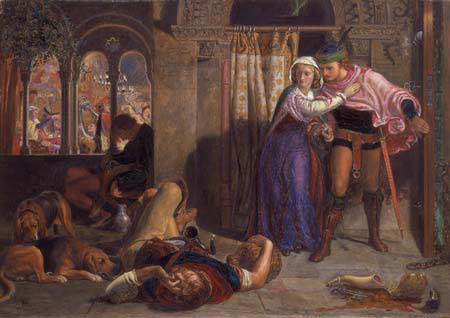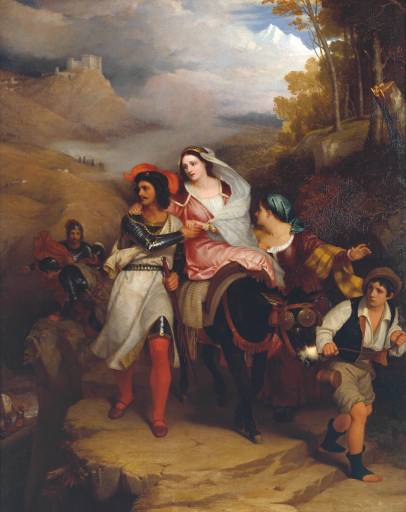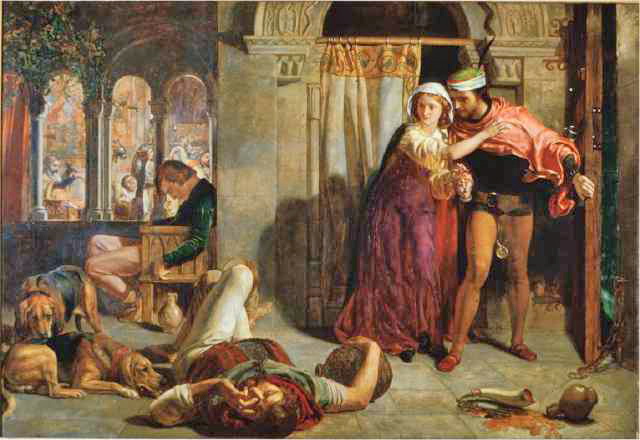The historiography of the Pre-Raphaelites has moved from an exploration of the individuals involved, the anecdotes of their lives, their lifestyles, loves and passions to a detailed analysis of their autobiographies and letters. We will take a multidisciplinary approach and look at the psychological alongside the technical and the biographical alongside the social. It is important not to reject the approaches of the past but to put them in a broader context that highlights common ground by comparing alternative perspectives.
The analysis will be approached under a number of headings and sub-headings rather than by individual. The exception will be Ruskin who is covered as an individual not because of his influence but to show how his influence has been overstated in the past.
There were male and female Pre-Raphaelite artists and we will ask if there is a gender specific way to make a painting. There were certainly gender-based social conventions and assumptions that will be explored and which influenced both male and female painters.
We start by asking how this small group of unknown, inexperienced artists gained their authority, in fact how does anyone gain authority. Griselda Pollock Avant-Garde Gambits 1888-1893 (1992, Walter Neurath Memorial Lecture, Birkbeck College) identifies the gambit of ‘reference, deference, and difference.’ That is authority is gained by reference to painters who are respected and their style is used (deference) but a difference is established. She also talks about the competition between artistic cannons (standards or rules) and how artists legitimize themselves by retrospectively selecting enabling predecessors. Today canons are established by museums, galleries and publishing houses and marginal groups in the past are obliterated.
Artistic Authority
- Kant, Romanticism and the embodied eye
- The artist and the establishment
- Brothers and revolutionaries
Gender, Love & Marriage
City & Country
Individuals
Religion, Death and the Body
Rossetti and the Aesthetes
- Dreamers and dealers
- Aesthetes and Dandies
- Degeneration
To Start at the Beginning
Consider Holman Hunt’s The Eve of St. Agnes, also known as “The flight of Madeline and Porphyro during the drunkenness attending the revelry“, which was exhibited at the Royal Academy in 1848. It is based on an old legend described by John Keats in his 1819 poem The Eve of St. Agnes. Holman Hunt had bought a copy of the neglected Romantic poet Keats and the painting illustrates the penultimate verse which was included by Hunt in the catalogue. The painting was given a good, well lit position and received plenty of attention.
The penultimate verse is:
They glide, like phantoms, into the wide hall;
Like phantoms, to the iron porch, they glide;
Where lay the Porter, in uneasy sprawl,
With a huge empty flagon by his side;
The wakeful bloodhound rose, and shook his hide,
But his sagacious eye an inmate owns:
By one, and one, the bolts full easy slide:
The chains lie silent on the footworn stones;
The key turns, and the door upon its hinges groan.
See Keats The Eve of St. Agnes for the full poem. Also see this Victorianweb article: The Theme of “The Eve of St. Agnes” in the Pre-Raphaelite Movement
The Eve of St. Agnes is based on the legends surrounding St. Agnes. St. Agnes was martyred in 304AD after being raped all night in a brothel (or, in some versions, being threatened with this and saved by a storm). Subsequent legend has it that if a virgin performs certain rituals (such as not looking backwards and sleeping on her back with her hands behind her head) on the Eve of St. Agnes (20th January) she will dream about the man she will marry. In Keats poem, Porphyro (meaning purple, the colour worn by nobility) is a knight that comes to the castle even though his enemies are gathered there. One old hag is a friend of Porphyro and hides him in Madeline’s wardrobe before she comes to bed. Madeline follows the Eve of St. Agnes rituals when she retires watched by Porphyro. She falls asleep and Porphyro tries to wake her with music, she eventually awakes and although she knows him she is initially afraid. They make love with the lines ‘Into her dream he melted, as the rose/Blendeth its odour with the violet,/Solution sweet:’. The original version was more explicit but Keats’s publisher forced the three explicit stanzas to be deleted. As Madeline has just woken it is possible she is still half asleep, the relevant lines are, ‘Her eyes were open, but she still beheld,/Now wide awake, the vision of her sleep:’. This raises the question of whether Madeline was fully consenting. Dawn breaks and they flee the castle and it is this verse that is illustrated by Hunt although in the poem the revellers have long since retired to bed. The poem ends at this point with a stanza starting ‘And they are gone: ay, ages long ago/These lovers fled away into the storm’. It is as if the poem is recounting a tale that happened long ago with this sharp change of tense. Finally the poem returns to the icy cold of the opening lines and in these freezing conditions the old hag and the ‘Beadsman’ both die.
In Hunt’s painting we see the interior of a medieval scene closely illustrating the poem by Keats. The style and content appear to reflects the ideas of a student of the Royal Academy wishing to be exhibited. It is a medieval subject which was popular, painted in a conventional style illustrating a Romantic poet (even though Keats was not well known at the time). Medieval revivalism was widely discussed and in 1844 Augustus Pugin had joined with Charles Barry to create a new medieval palace at Westminster to replace the Houses of Parliament that had burned down in 1834. There had been a medieval revival across Europe, for example, the Nazarenes in Rome. This picture has a Romantic feel as it expresses emotion and has a freer brushstrokes than later Hunt paintings in the ‘Pre-Raphaelite style’. For an introduction to the aims and objectives of the PRB see Wikipedia’s Pre-Raphaelite Brotherhood (PRB).
This painting is the one that in some ways brought the PRB together. Rossetti saw it at the Royal Academy and contacted Hunt to praise him. Simplistically the painting shows a typical student scene of drinking and sex. We can look through the picture for symbols as the PRB made heavy use of symbols (see Rossetti’s “The Childhood of Mary Virgin”). Remember the painting was painted and shown in 1848, the year of riots across Europe and in London the massive Chartist demonstration that Hunt attended. It was an exciting and energetic period and change was in the air.
Compare it first with the sketch that pre-dated the painting but was also worked on for a further 10 years. It can be seen that Hunt added a lot of further detail to the sketch in the Pre-Raphaelite style. Although the painting is conventional in many ways the composition is not the standard pyramid (see the Eastlake below). The composition splits into two areas that are loosely held together illustrating two ‘worlds’, the lovers and the party. The figure on the floor looks like a student drawing exercise in foreshortening. What was Hunt’s relationship with other art? As mentioned above this question is answered by Griselda Pollock in “Avant Garde Gambit”, basically avant garde artists refer to established artists (“reference”), copy elements of their style (“deference”) and then add their own originality (“difference”).

A great deal could be written about the couple. The most interesting approach is to look at Madeline as the hero rather than the heroine. She is adopting a posture of control with one foot raised and her hand controlling Porphyro and an X-ray analysis shows that Madeline’s hood has been rounded to look more like a halo. Porphyro has his hand on his sword and seems poised for action but Madeline is more alert and conscious of the danger from the dog barking and alerting the guests and he seems to be looking at the sleeping guard who is less of a danger.
Compare Charles Eastlake’s The Escape of Francesco Novello di Carrara, with his Wife, from the Duke of Milan, exhibited 1850. We must always balance evidence against interpretation as the two go hand in hand. All interpretation must be closely based on the evidence of the painting or associated documented historic events.

It has a more conventional pyramidal design, a softer painterly style and the idealised woman is straight from Raphael and the boy on the right from a Murillo. Note how the man and woman have changed places in Hunt’s painting. This creates a tension as it raises questions about the roles of men and women as they were starting to be raised in Victorian society. In this sense Hunt’s painting is contemporary even though it illustrates a medieval theme.
How the PRB was Formed
The three key members and the first three members were William Holman Hunt (1827-1910), John Everett Millais (1829-96) and Dante Gabriel Rossetti (1828-82).
- Hunt came from a poorer family and his father, a warehouse manager, was against his career as an artist so he worked, trained in the evenings at the
mechanics institute and spent his salary on lessons with a portraitist. He met Millais at the British Museum in 1844 and Millais encouraged him to apply for the Royal Academy training, and on the third attempt he was accepted at the end of 1844. Hunt was hard working, religious, unconventional in his approach to art, much liked and very jovial (he was called the ‘Maniac’). - Millais was a child prodigy from a wealthy family who supported his talents. He went to Sass’s (a prep school for the Royal Academy) in 1839 aged 10 but only needed one year there and he went to the Royal Academy school in 1840 aged 11. He was honest, sincere and other artists were awed by his talents and charmed by his personality. He was committed to art and according to Hunt he never wasted a moment in his dedication to painting.
- Rossetti was from an intellectual family but he was not a natural painter and spent four years at Sass’s (1841-5) from the age of 13 to 17. He went to
the Royal Academy in 1845 but his attendance was erratic. He admired William Blake and Robert Browning and was as much a poet as an artist. He dropped out of the Academy and was accepted (eventually!) by Ford Maddox Brown for art lessons in 1848. A few weeks later he saw Hunt’s Eve of St. Agnes, Keats was a favourite of Rossetti and he approached Hunt and congratulated him. See the Rossetti archives.
Rossetti and Hunt became friends and Hunt started to give him instruction which soured the relationship between Brown and Hunt. Hunt sold Eve of St. Agnes for £70 and rented a studio in 7 Cleveland Street, Fitzroy Square. Millais had been away in Oxford the summer of 1848 and when he returned Hunt suggested they get together with Rossetti. It is conventionally thought that the three original founders started in September 1848 and that the name was a combination of ‘Pre-Raphaelite’, based on a comment made by another student when Hunt and Millais were heard criticizing Raphael; and ‘Brotherhood’ from Rossetti, perhaps from his desire to create a secret societies.
They believed that from the time of Raphael there had been a ‘grandiose disregard for the simplicity of truth’ and this had been continued by the teaching of Reynolds and the training of the Royal Academy. Millais used the word ‘slosh’ for loosely painted work, for example, the way leaves of trees were often scumbled in dark brown.
From Cleveland Street they would have walked past Rossetti’s parents house in Charlotte Street, across Tottenham Court Road to Millais’s family home at 83 Gower Street. Between Cleveland Street and Gower Street the PRB started worked. Rossetti on The Childhood of Mary Virgin (1848-9) with Hunt’s help, Millais on Isabella (1849) after he had completed Cymon and Iphigenia (1848-51) and Hunt on Rienzi vowing to obtain justice for the death of his young brother, slain in a skirmish between the Colonna and the Orsini factions (1849).
The three decided they needed to extend their numbers and they invited a motley crew. Rejecting Ford Madox Brown as an obvious choice, perhaps because Hunt disliked
him they invited:
- Thomas Woolner, the sculptor, 23 years old, moderately successful, slender talent and an amateur poet. His other claim to membership was that he disliked the Academy as he thought they did not support sculpture.
- William Michael Rossetti, Rossetti’s brother, who was a civil servant not an
artist. - James Collinson, a successful RA student who was thought to be about
to marry Rossetti’s sister Christina. - Frederick George Stephens, Hunt’s friend and the only candidate who had
never painted a picture.
This created the original brotherhood of seven and the group was never
extended officially but many more artists are now classified as PRB painters.
What we might call close associates of the PRB include,
- Ford Madox Brown (1821-1893, travelled in Italy and France, painted Work and the Manchester Town Hall cycle)
- Elizabeth Sidall (1829-1862, spelt ‘Siddal’ by Rossetti, an artist, she married Rossetti and died of a laudanum overdose)
- Walter Deverell (1827-1854, born in US, discovered Elizabeth Siddall, died young, it is said Sidall loved him)
and in Phase 2,
- Edward Burne-Jones (1833-1898), brought the PRB into the mainstream, studied theology, met William Morris, influenced by John Ruskin) and
- Simeon Solomon (1840-1905, Jewish, artistic family, original artist but arrested for sodomy in 1873, went France and was arrested again, became an alcoholic
and what we might call followers or associates including,
- William Dyce (1806-1864, Scottish, selected to paint the Westminster frescoes),
- Augustus Egg (1816-1863, wealthy family, member of the The Clique, his moral genre paintings were popular),
- George Frederic Watts (1817-1904, allegorical works, Symbolist, influenced by Italian art and Rossetti, married Ellen Terry when she was 17 and he was 47),
- Walter Osborne (1859-1903, Irish impressionist),
- Arthur Hughes (1831-1915, April Love a copy of Millais’s couples, died leaving 700 paintings)
- John Brett (1831-1902, RA student, influenced by John Ruskin and Hunt, The
Stonebreaker, carefully executed landscapes) - Henry Wallis (1830-1916, Death of Chatterton RA 1856 – vibrant colours, all-over detail, symbolic associations)
It could also be argued that there were two phases of Pre-Raphaelitism:
- Phase 1: 1848-1853, Hunt, Millais and Rossetti. Phase 1 ended in 1853 when Millais became an ARA and Hunt left for the Middle East in 1854 not to return until 1856.
- Phase 2: 1854-1882, was more complex,
-
There were three main circles of ‘avant garde’ artists in London, one centred around Rossetti in Chelsea, one around Leighton near Holland Park (now the Leighton House Museum) and the third around Morris in Hammersmith. Holland Park was also the home of Watts. In 1861 Morris co-founded ‘the Firm’ which combined medieval craftsmanship with decorative aestheticism.
-
In 1857, Rossetti encouraged William Morris and Burne-Jones to paint the Debating Room fresco of Sir Thomas Malory’s Morte D’Arthur. In 1859 Rossetti painted the first of his ‘female heads with floral ornaments’ Bocca Baciata. Later Swinburne joined Rossetti’s group and James Whistler became associated with it and the group was later known as the Aesthetes.
-
Millais and Hunt were outside these circles although they knew the artists in them. Millais went on to become rich and famous, was made a Baronet in 1885 and for six months before he died in 1896 was President of the RA. He smoked all his life and died of throat cancer. Hunt stayed dedicated to the Pre-Raphaelite ideals with his own strong religious theme.
-
Notes
- There are different stories about how the Pre-Raphaelite Brotherhood acquired its name:
- The name ‘Pre-Raphaelite’ came from Rossetti’s reading of Lord Houghton’s ‘Life and Letters of Keats’ which according to Rossetti says ‘the early men surpassed even Raphael himself’;
- Ford Madox Brown claims he told them about the Pre-Raphaelites (a familiar term in the art world at the time) and this is why they chose it.
- Hunt claims it was because when he and Millais were criticizing Raphael’s Transfiguration a fellow student said ‘Then you are Pre-Raphaelites.”
- The term “Brotherhood” almost certainly comes from Rossetti, perhaps with Italianate feelings of a cosa nostra.
- The initial meeting of the PRB was probably in early September 1848 (possibly the evening of the Saturday 9th or Sunday 10th) in Millais’s studio in Gower Street.
- Rossetti never exhibited at the Royal Academy. In 1849, at the last minute he chickened out and paid to be exhibited at the Free Exhibition (held one week earlier) without telling Hunt or Millais. Hunt forgave him but Millais never did as they were meant to be a united brotherhood acting together to change the art world.
- It could be argued that the Brotherhood only lasted until 1853 when Hunt went to the Middle East and Rossetti and Millais stopped talking.
[This page is based on notes taken during a course given at Birkbeck College, London University, by Carol Jacobi in 2006/2007]

